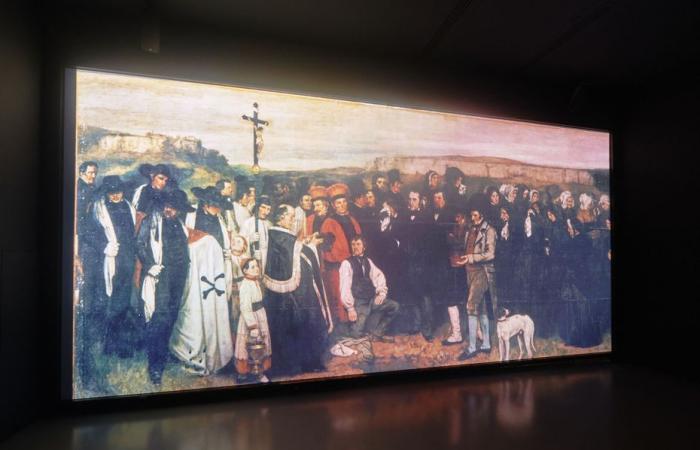
The Musée d’Orsay in Paris unveils an unprecedented project: the public restoration of a masterpiece by Gustave Courbet, “a burial in Ornans”. Visitors will be able to follow the work of restaurateurs live. Commented visits will also be offered.
Most of the day: our exclusive selection
Every day, our editorial staff reserves you the best of the regional info. A selection just for you, to stay in connection with your regions.
France Télévisions uses your email address to send you the newsletter “The essentials of the day: our exclusive selection”. You can unsubscribe at any time via the link at the bottom of this newsletter. Our Privacy Policy
The public of the Musée d’Orsay in Paris will be able to follow the complete restoration of a monumental painting by the painter Gustave Courbet (1819-1877), “a burial in Ornans”, produced between 1849 and 1850, is extremely rare. Since 2019, the Rijksmuseum of Amsterdam has already bet to renovate in public “La Ronde de Nuit” by Rembrandt, masterpiece of the Dutch Golden Age (XVII).
“A burial in Ornans” was produced between 1849 and 1850. • © MAXPPP
Presented Monday, May 5 in the temple of impressionism, the restoration of “a burial in Ornans” will take place within a closed space specially fitted out on the ground floor where the painting is usually hung. She intervenes ten years after that of “L’Atelier du Painter”, another major work by Courbet. The site was isolated by a palisade with bay windows to allow the public to follow the work of restaurateurs live. Commented visits will also be offered free of charge by reservation.
“A burial in Ornans” is a “Major table of the collections of the Musée d’Orsay”. Il “has never been the subject of a fundamental restoration and is no longer readable today at the height of the shock he has aroused” When the 19th century public discovered it, said France Press Agency Sylvain AMIC, president of the public establishment of the Musée d’Orsay and the Orangery.
Its chassis is distorted and caused a relaxation of the linen canvas formed by four injuries whose seams are weakened. The successive layers of varnish also opacified colors and details, according to restaurateurs.
Read also: The erotic correspondence of Gustave Courbet discovered in an attic, a secret hidden for 150 years
When Gustave Courbet exhibits it at the Salon (main contemporary art salon at the time, editor’s note) of 1850, this painting with dark dominants punctuated by red, will create “A blast”underlines Isode Pludermacher, general conservative painting at the Musée d’Orsay.
The one who paint in 1866 “the origin of the world” and who has already received a gold medal at the Salon of 1849, “shock” deeply his contemporaries “by the monumental format (nearly 7 m by more than 3 m) usually reserved for historical, religious or mythological scenes, which he attributes to a genre scene, a burial “.
Read also: Videos. In the footsteps of Jean-Paul Mazaroz, cabinetmaker, patron of Gustave Courbet and thinker of the Jura
He represents there “country people”, By painting in a very realistic way of the inhabitants of his native village, Ornans (Doubs), which he scrolls through his workshop. He refuses to idealize the figures, qualified “ignoble” by certain criticisms that are unleashed on “Trognes” beades “As red as their clothes” And compare the work to the images that decorate the fairgrounds, adds the specialist. Courbet will make its aesthetic manifesto, that of realism.
Gustave Courbet was from Ornans in Doubs. • © HTTP://IMAGEBROKER.COM/#/SEARCH/8280411
The unstable political context and the presence of two revolutionaries of 1793 facing the gravedigger adds to the political dimension of the work. It intervenes just after the working days of workers in June 1848 and precedes by a few months the coup d’etat of Prince-President Louis Napoleon Bonaparte. Some will interpret the painting as the burial of the Second Republic by the Bonapartists. Courbet exhibited it several times before refusing to move it due to the fragility of the canvas.
The table “Do not suffer from deep alterations, but it is covered with a yellow filter due to the layers of successive varnish which covered it. Certain parts of the original canvas have been folded on the edges and one of the issues is whether it can win or not on the surface”, explained Bruno Mottin, specialist in Courbet and former study manager at the C2RMF, the laboratory of Museums of France.“The knife poverty also caused cracks and lead white produced micro-spheres altering the canvas”, Detailed Cinzia Pasquali, head of pictorial catering.
Read also: “I got into his paintings and he got into my life”, the writer and journalist Sandrine Treiner investigates Gustave Courbet
“A burial in Ornans” was offered in 1881 to the Louvre museum by the painter’s family after his death. He joined the Orsay collections at its opening in 1986. Restoration must last between 12 and 18 months. After a first phase of studies including a complete radiographic imagery file made at C2RMF, its first step will consist of “Gradually slim the altered varnish and retouching of the few previous restorations”. Its funding, the cost of which has not been specified, is ensured by a patronage of Bank of America.
Homeden Smart-acut, AFP







